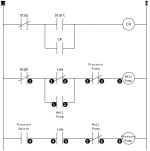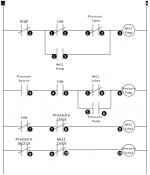laketime
Senior Member
I have a customer who is now controlling a small water system for his neighborhood. They have two pumps; one for the well that pumps to a reservoir and another that is in the reservoir that pressurizes the system. The issue is that we are installing a back up generator system that is undersized for both pumps to kick on at the same time (a rare case). They want a 3 minute lag from when the reservoir tank kicks on until the well pump starts. I had planned to use a time delay relay to comtrol the well pump. Reservoir turns on...three minutes later well pump turns on. I have limited exeprience designing these systems but my concern is this: reservoir pump turns on, three minutes later well pump turns on, then reservoir pump turns off, will well pump keep running or will my idea to use to reservoir pump power to control time delay relay shut off well pump? I could use come help with design obviously and I am sure there is a way to keep well pump running until reservoir is full. I have also thought about using the float in the reservoir as control for the well pump, as it is already, but put the time delay in the middle of that circuit. My concern there is that it does not address the reservoir pump starting at the same time. In short....help!



